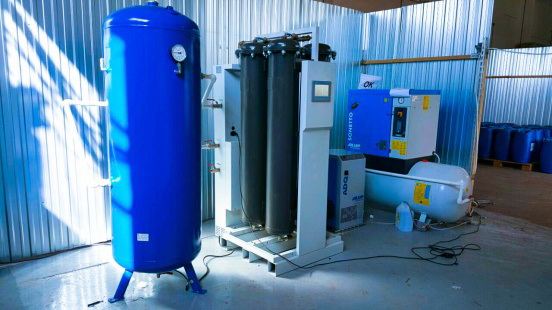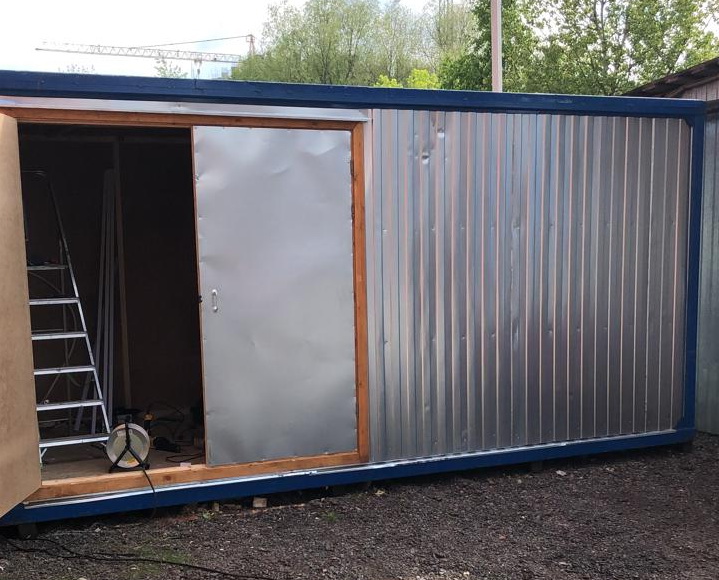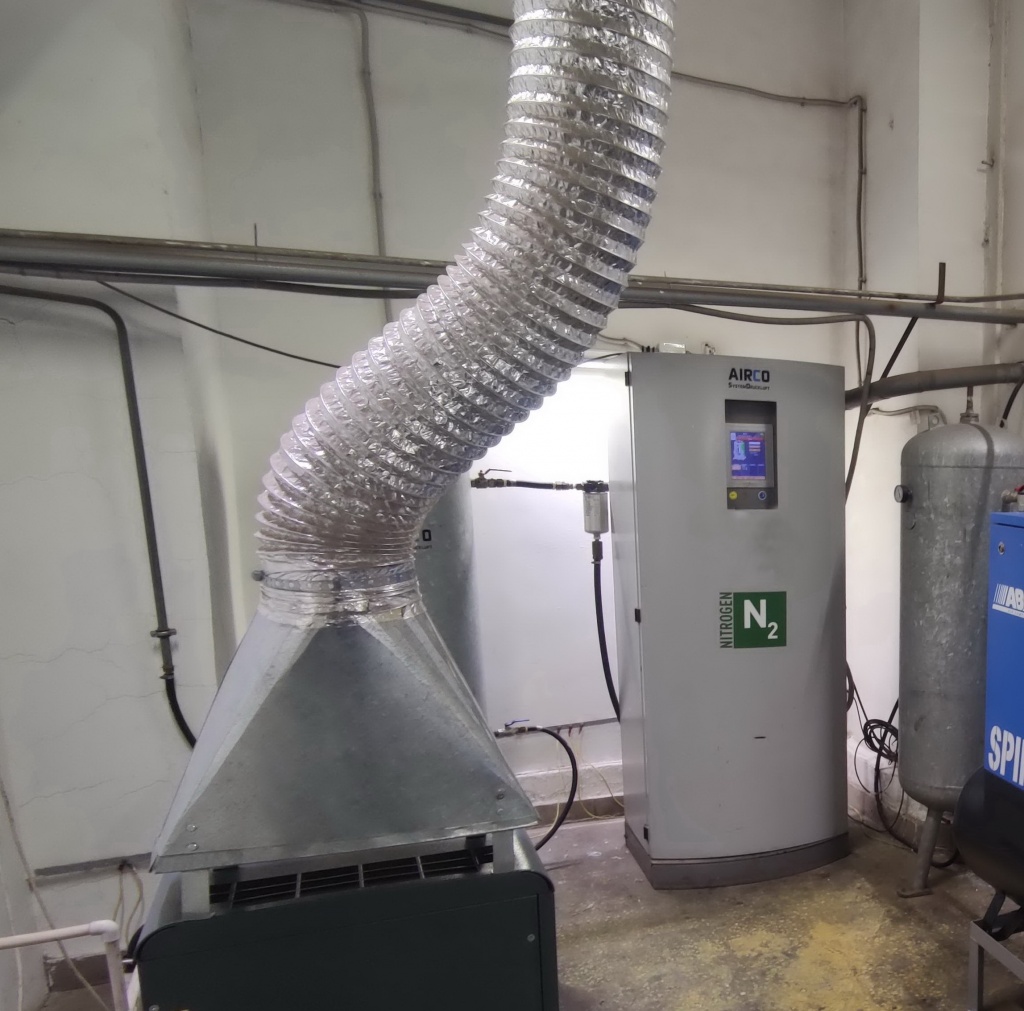Placement rules
Basic data for the placement of equipment in the production
Room size: when calculating the room, take into account the dimensions of all the elements of the plant and leave about 16.4 ft. around each piece of equipment. The height of the room should be at least +6.5 ft. from the height of the generator, this is usually the highest element of the system.Temperature range: +41... +104 degrees Fahrenheit
It is necessary to have ventilation in the room and the possibility of condensate drainage.
A detailed description of the room requirements.
The size of the room can be easily calculated by knowing the dimensions of each element of the station. All elements of the station can be arranged in any order, following the sequence of connections. Often the equipment is placed along the wall, then it is easy to maintain and there is easy access to each element. A distance of 1.6 ft. allows for 2 - 3 ft. on one side and 1 - 2 ft. on the other side. Some norms require placing equipment at a distance of 3 ft. from the walls of the building - if there is such a possibility, you can take it into account, if the room does not allow it, you can place the equipment a little closer. Examples of equipment placement can be seen on the page of completed works Also, when selecting a room, you need to consider the dimensions of the entrance gate/door in order to be able to carry out the installation. We provide all the dimensions of the equipment and you can easily check the dimensions of your entrance gate/doors.
Also, when selecting a room, you need to consider the dimensions of the entrance gate/door in order to be able to carry out the installation. We provide all the dimensions of the equipment and you can easily check the dimensions of your entrance gate/doors.It is possible to place equipment in basements, floors and utility rooms. In this case it is necessary to consider ventilation requirements, which are described below and also the weight of the equipment. Equipment is often heavy and the movement on the stairs and in remote places is not always possible. Consider the weight and you can always estimate your strength to move the equipment.
All equipment can be moved on an industrial rohle or with the help of a loader, for which there are special holes in the equipment. It is also possible to transport all the elements with a crane or other lifting mechanisms.
Temperature regime should be observed within the range from +41 to +104 degrees Fahrenheit primarily because of the requirements to the air compressor, where the oil and below the temperature +41 degrees Fahrenheit, it becomes more dense and it may have a negative impact on the work of the compressor. The same applies to higher temperatures - air compressors are designed to allow normal operation in such conditions. An air compressor generates a lot of heat and that heat can be used to heat the room. Sometimes a simple mechanical damper is installed on the exhaust vent from the compressor to control the flow of air from the compressor and to vent it to the outside or to the room. Thus, sometimes appropriate to use heat guns or other heating to heat the room to +41 degrees Fahrenheit, and then use heat from the air compressor.
In hot weather for maintenance of the temperature regime it is necessary to air the room well and necessarily to remove the hot air from the compressor.
Generators are designed to work at +70 degrees Fahrenheit and when the room temperature rises to +90 to +100 degrees Fahrenheit may slightly reduce the concentration of produced nitrogen/oxygen within 5-10%.
Container

The nitrogen/oxygen generation system can be placed in containers, quick buildings made of sandwich panels and other materials, taking into account your climatic conditions. If you make the room yourself, we recommend using 0.3 ft. sandwich panels or in the case of metal sheet walls provide insulation of 0.3 ft. This is enough and as practice shows it can be used even in the far north.
When using a refrigerated dehumidifier, all pneumatic lines and air receivers should be located in a room with the same requirements as the main equipment.
The nitrogen/oxygen receiver as well as the nitrogen/oxygen lines can be located outdoors, routed or installed outside. This is due to the "humidity" of the air/gas, which is measured in dew point temperature. After a refrigerator dehumidifier the air dew-point temperature is +37...+41 degrees Fahrenheit, after an adsorption dehumidifier it is -68..-104 degrees Fahrenheit, after a nitrogen/oxygen generator -122...-176 degrees Fahrenheit. It means that at this temperature condensate may form inside the line. Thus if we want to place air receivers and lines outside we need to use adsorptive dehumidifier (the dehumidifier itself should work indoors). And all the lines and gas receivers can be placed outside without any problems.
Ventilation

Ventilation can be installed after installation of equipment, if you have a small station (up to 10 000 SCFH)
For the compressor - this is primarily the removal of heat, hot air from the room. Such ventilation can be organized on site, after installation of the compressor.
For a nitrogen/oxygen generator, this is removal of waste gase. This can also be done after installation of the station. At the outlet of the nitrogen generator we have air with oxygen content of about 28-35%. It is not dangerous, but it is not recommended to leave it in a closed room. At the outlet of the oxygen generator we have air with reduced oxygen content, it can be about 5-15% oxygen. The oxygen content of atmospheric air is 20.9%.
If you have a large industrial space with high ceilings and ventilation is organized in the room, you can do without additional measures.
We recommend installing a wall-mounted oxygen sensor and thermometer in the room next to the generator in order to monitor the air in the room and to take measures during the operation of the equipment. The wall-mounted oxygen sensor is a relatively inexpensive and simple device.
Condensate drain

Also during installation it is necessary to take into account condensate drainage. Condensate is formed in air receivers, air dryer, filters. Automatic systems are often used to drain the condensate from these elements, which are called "automatic condensate drain". This is a device that opens and closes a pneumatic line to drain the condensate, usually once every few minutes or sometimes they have a "float" trigger system and open as needed. It is recommended to drain the condensate into the sewer. Temporary condensate containers can be used and drained manually. This is often used in small systems with a capacity of up to 1500-3500 SCFH of gas. The condensate drain line is a flexible tube, 0,03 ft. in diameter, which is often sufficient. We do not recommend draining the condensate outdoors, because firstly in winter part of the tube that is outdoors may freeze, and secondly there may be a small amount of oil in the condensate that remains after the compressor. This is called "natural carry-over" of oil from the compressor.
Electricity
The main consumer of electricity is the air compressor. It is 380V. You will need an electrical cabinet where you can connect the equipment directly. And also you need to provide lighting in the room to work and a few outlets - for a nitrogen generator (220V) and a dehumidifier (220V), their power is always specified in the technical specifications. Generator consumes less power than computer. It is necessary to have grounding.The requirements are generally very simple and you can always make the necessary small utility room in the form of a container/hut and run the line to your main production on the street. The line can be up to 328 ft. long and you only need to put an additional gas receiver near the consumer inside the room. You have to take into account the pressure loss on such a line, but often for the consumer this is not critical.

